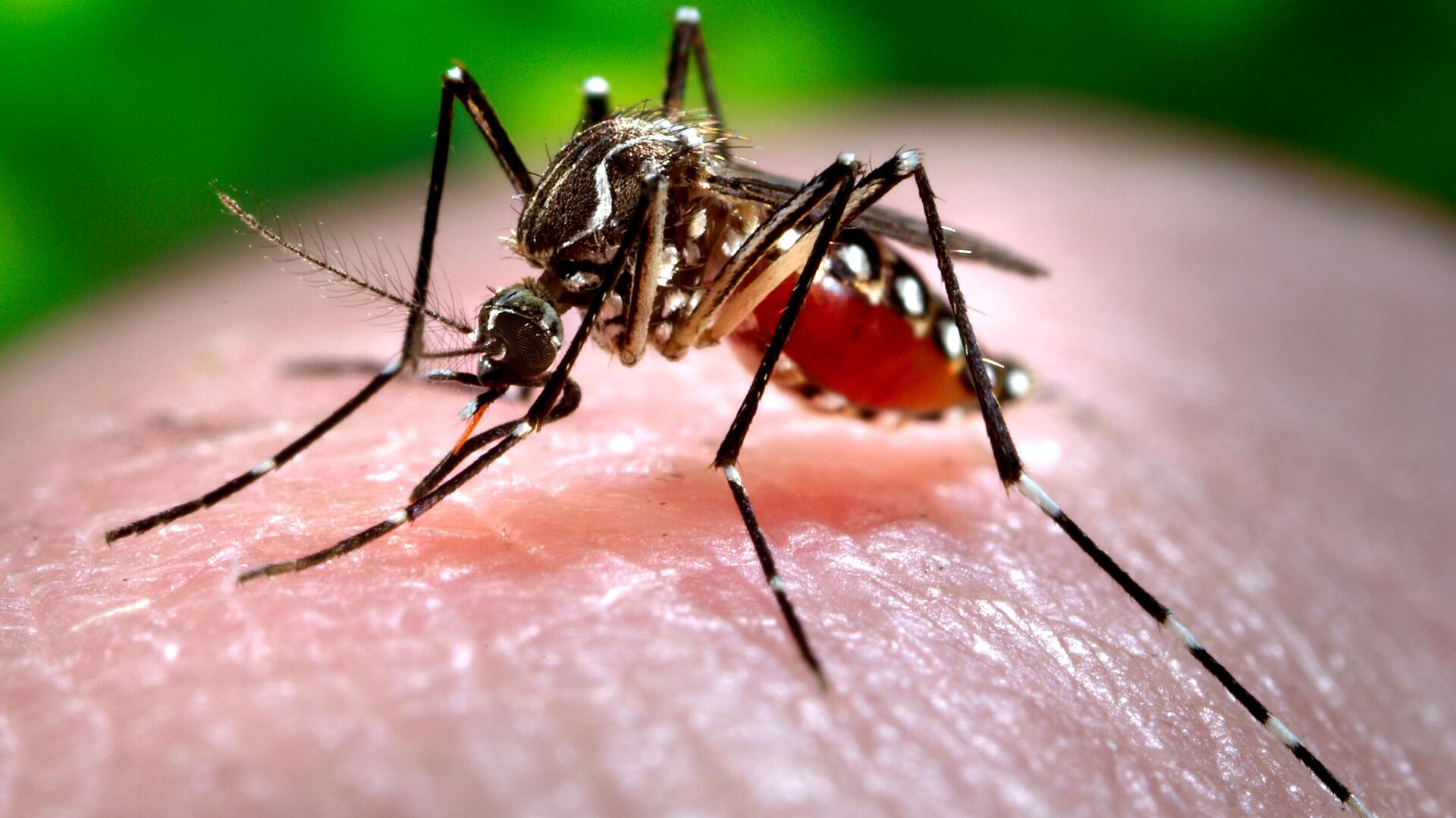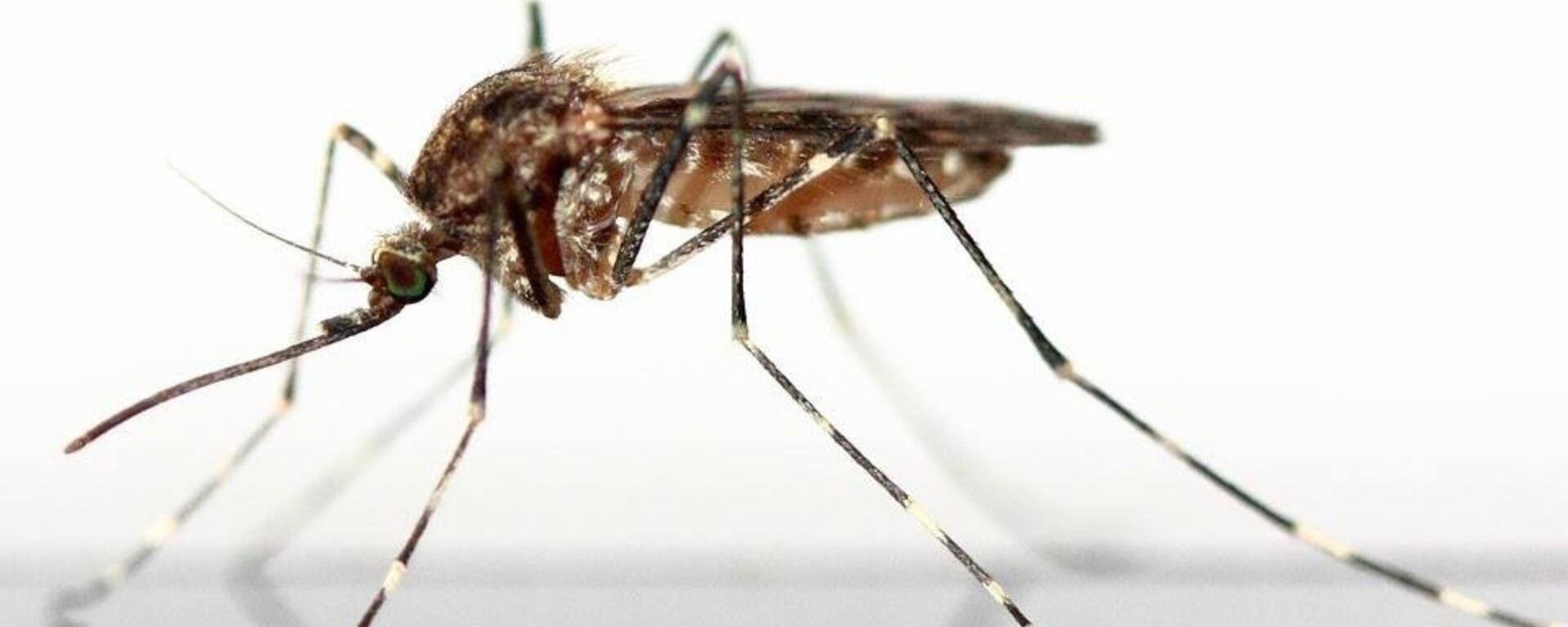https://sputnikglobe.com/20230114/what-are-the-symptoms--dangers-of-murray-valley-encephalitis-virus-1106312356.html
What are the Symptoms & Dangers of Murray Valley Encephalitis Virus?
What are the Symptoms & Dangers of Murray Valley Encephalitis Virus?
Sputnik International
Mosquitoes carrying the potentially deadly Murray Valley encephalitis disease have been reported in the Darling River town of Menindee, according to Australia's New South Wales health service, with the department warning on January 11 that the virus has no vaccine.
2023-01-14T15:13+0000
2023-01-14T15:13+0000
2023-04-21T10:43+0000
mosquitoes
sputnik explains
south australia
mosquito bite
fever
symptoms
encephalitis virus
murray valley encephalitis
virus
science & tech
https://cdn1.img.sputnikglobe.com/img/07e7/01/0e/1106324012_0:190:2967:1858_1920x0_80_0_0_5b026ef6c3982d23f3690538d8045fda.jpg
The recent detection of mosquitoes carrying the rare, but potentially fatal Murray Valley Encephalitis virus has prompted a health alert from Australia's health authorities. The virus was found for the first time in over a decade in the country's state of Victoria, with the state's Health Department confirming a case on January 13. The alarming news came a day after the virus was recorded in Menindee, a small outback settlement on the banks of the Darling River in the far west of New South Wales. According to NSW Health, the incidence could possibly be traced to above-average rainfall and subsequent flooding that first started in Menindee in December, 2022, and has persisted unabated.Richard Broome, the executive director of the Health Ministry of NSW, warned people to try and dodge mosquito bites, adding that there does not exist any vaccination or specific treatment for MVE.Here is what is known about the Murray Valley Encephalitis virus, its transmission, and symptoms.What is the Murray Valley Encephalitis Virus?Murray Valley encephalitis (MVE) virus is a type of arbovirus that is mosquito-borne. Arboviruses are typically transmitted via insect bites. The serious viral infection is a member of the Japanese encephalitis serological complex of flaviviruses. The latter also includes Japanese encephalitis virus (JEV). Incidentally, MVE is often clinically impossible to distinguish from Japanese encephalitis, with medics urged to test for both viruses. Japanese encephalitis, a mosquito-borne viral brain infection, is a deadly disease caused by the Flavivirus virus, which can infect both humans and animals. The brain infection is commonly found in rural Southeast Asia, the Pacific islands, and the Far East, with people asymptomatic in most cases. When there is severe infection, they may experience neck stiffness, coma, and more rarely, permanent neurological complications or death.While the mosquito is more often than not the culprit when it comes to such arboviral diseases, other arthropods can also be faulted for spreading such infections, such as ticks or fleas. But in the case of the uncommon Murray Valley Encephalitis virus, it is spread by mosquitoes from infected animals to humans.Where is Murray Valley Encephalitis Virus a Problem?The MVE virus is endemic, or predominantly restricted, to northern Australia, the island country of Papua New Guinea, located in the southwestern Pacific, and Indonesia. Some of the first epidemics of MVE were registered in 1917-1918 in southeastern Australia. The virus, typically occurring after successive heavy rainy seasons and subsequent flooding, was only isolated from human samples in 1951. At the time, an epidemic raged in Murray Valley of Australia - hence the name, Murray Valley Encephalitis Virus.According to health guidelines, in such areas and during an epidemic, people risk being infected if they spend a lot of time outdoors, go camping, hiking, or choose to set off on travels during a season when mosquitoes are more common, like summer.How Do Mosquitoes Get Encephalitis Virus?Pesky insects that they are, mosquitoes can catch the virus in question as they swoop down to suck the blood of birds such as freshwater herons or the long-legged, sharp-billed egret, which wades through water as it feeds. Such diseases, spread by insects, are known as "vector-borne" ones. There is no proof that the Murray Valley Encephalitis virus can be transmitted directly from one person to another. Furthermore, individuals cannot catch the virus by touching an infected animal or if they eat animal products. Why is Murray Valley Encephalitis Virus Dangerous?The Murray Valley Encephalitis virus can, in rare instances, cause a severe neurological illness, fraught with lifelong complications - Murray Valley Encephalitis. Symptomatic disease is estimated to manifest itself in between 1 in 150 and 1 in 1,000 MVEV infections. Potentially life-threatening and requiring urgent hospital treatment, the inflammation of the brain that is caused by encephalitis can target anyone; however, very young and very old individuals are at greatest risk. Generally, encephalitis affects people very differently. What Are the Symptoms of MVE Virus?The tricky thing about being infected with the MVE virus is that in the case of the majority of such people, no symptoms manifest themselves. Health authorities recommend laboratory testing for MVE virus infection via blood, urine, and spinal fluid (CSF) samples. According to recent clinical data, less than one percent of individuals who contract the virus actually develop any clinical disease. However, if a one finds oneself among those rare instances, then symptoms start about 7 to 12 days after being exposed to the virus, as a rule. On a broader scale, signs of MVE virus may crop up from 5 to 28 days post-exposure.When they do occur in a small proportion of affected people, the symptoms include nausea, vomiting, fever, worsening headache, muscle aches, sensitivity to bright lights, drowsiness, disorientation, convulsions, unconsciousness, or they may fall into a coma. People can develop meningitis or encephalitis in rare cases. Unfortunately, there are no means by which it can be determined if a person will suffer a mild or a severe form of MVE.As vaccinations or specific treatments for Murray Valley Encephalitis do not exist, the best way to dodge infection is to avoid being bitten by mosquitoes - active between dusk and dawn - that spread the virus. Lavishly applying repellent to exposed areas of skin and using insecticide sprays is advised.What Causes Encephalitis?Generally, encephalitis – an inflammation of the brain’s active tissues – can be caused by anything ranging from a viral infection (like herpes or chickenpox), to a bacterial or fungal one. Other causes can be issues with the body's immune system (autoimmune inflammation). Incidentally, like COVID-19, the severe acute respiratory syndrome caused by the SARS-CoV-2 virus, it may sometimes result in immunosuppression of the cells of the brain, weakening our immune system. Among severely ill patients, encephalitis was registered as a neurological complication of the disease.As to what happens when one develops encephalitis, to put it simply, there is a marked swelling of the brain's active tissues in the temporal lobe. This section of the brain is responsible for memory and speech control. At times, the disease impacts the frontal lobe - guiding our behavior and emotions.All of this is potentially dangerous as it can impair the brain to an extent that the patient will suffer long-term problems, such as loss of memory, speech and language complications, and even personality changes. As for the symptoms, they can vary hugely in individuals. While some may get away with only mild flu-like signs, marked by a fever or headache, others experience no issues whatsoever. Those who are not so fortunate may have to deal with confusion, seizures, or difficulty moving, with their hearing and vision at times impaired.How Can You Confirm Encephalitis?If an individual were to fall into the limited category of those who develop encephalitis after contracting the Murray Valley Encephalitis virus, there are blood, spinal fluid, and urine tests, along with computed tomography (CT) and electroencephalography (EEG) tests that can help confirm it. In fact, anything that measures the electrical activity in a human brain can be used to prove the condition of encephalitis. In some tests, excretions are taken from the back of the throat to test for viruses or other infectious agents. The condition prompting the brain to become inflamed or swollen can show up on magnetic resonance imaging (MRI). An MRI scan that relies on powerful magnetic fields and utilizes computer-generated radio waves to turn out detailed images can be relied upon to confirm if an individual has encephalitis.How is Murray Valley Encephalitis Treated Today?As there are no vaccines or medical cures for the MVE virus, anyone suspected of having caught it is recommended to be promptly taken to hospital for medical treatment, which presupposes managing the symptoms. In other words, with no therapeutic options available, the treatment of MVE boils down to supportive or, in some cases, intensive case.As to how long the brain inflammation linked with encephalitis can last, health experts note that even after infection is gone, some symptoms affecting brain functioning may linger on for months, or even as long as years. While in numerous cases people achieve a good recovery from encephalitis, some of the gravest cases require forms of rehabilitation.These range from physiotherapy to speech therapy, etc. Severe outcomes result in people being left paralyzed or with permanent brain damage. An estimated 15 percent of individuals who suffer from the most life-threatening cases of MVE fail to survive.On the bright side, people who have caught the MVE infection go on to develop long-lasting, possibly life-long immunity to the virus.
https://sputnikglobe.com/20220716/japanese-encephalitis-claims-23-lives-in-indias-assam-since-april-reports-1097372705.html
https://sputnikglobe.com/20230111/no-vaccine-potentially-deadly-virus-emerges-in-australia-1106231142.html
https://sputnikglobe.com/20220901/russian-scientists-create-structures-to-improve-quality-of-mri-scanning-1100272915.html
https://sputnikglobe.com/20190618/head-of-indian-state-of-bihar-faces-public-fury-over-encephalitis-epidemic-1075935107.html
south australia
Sputnik International
feedback@sputniknews.com
+74956456601
MIA „Rosiya Segodnya“
2023
News
en_EN
Sputnik International
feedback@sputniknews.com
+74956456601
MIA „Rosiya Segodnya“
Sputnik International
feedback@sputniknews.com
+74956456601
MIA „Rosiya Segodnya“
murray valley encephalitis virus, murray valley encephalitis, murray valley encephalitis in australia, what is known about murray valley encephalitis virus, murray valley encephalitis virus symptoms, murray valley encephalitis vaccine, mosquitoes carrying encephalitis virus, symptoms of murray valley encephalitis
murray valley encephalitis virus, murray valley encephalitis, murray valley encephalitis in australia, what is known about murray valley encephalitis virus, murray valley encephalitis virus symptoms, murray valley encephalitis vaccine, mosquitoes carrying encephalitis virus, symptoms of murray valley encephalitis
The recent detection of
mosquitoes carrying the rare, but potentially fatal Murray Valley Encephalitis virus has prompted a health alert from Australia's health authorities. The virus was found for the first time in over a decade in the country's state of Victoria, with the state's Health Department confirming a case on January 13.
The alarming news came a day after the virus was recorded in Menindee, a small outback settlement on the banks of the Darling River in the far west of New South Wales. According to NSW Health, the incidence could possibly be traced to above-average rainfall and subsequent flooding that first started in Menindee in December, 2022, and has persisted unabated.
Richard Broome, the executive director of the Health Ministry of NSW, warned people to try and dodge mosquito bites, adding that there does not exist any vaccination or specific treatment for MVE.
Here is what is known about the Murray Valley Encephalitis virus, its transmission, and symptoms.
What is the Murray Valley Encephalitis Virus?
Murray Valley encephalitis (MVE) virus is a type of arbovirus that is mosquito-borne. Arboviruses are typically transmitted via insect bites. The serious viral infection is a member of the Japanese encephalitis serological complex of flaviviruses. The latter also includes Japanese encephalitis virus (JEV). Incidentally, MVE is often clinically impossible to distinguish from Japanese encephalitis, with medics urged to test for both viruses.
Japanese encephalitis, a mosquito-borne viral brain infection, is a deadly disease caused by the Flavivirus virus, which can infect both humans and animals. The brain infection is commonly found in rural Southeast Asia, the Pacific islands, and the Far East, with people asymptomatic in most cases. When there is severe infection, they may experience neck stiffness, coma, and more rarely, permanent neurological complications or death.
While the mosquito is more often than not the culprit when it comes to such arboviral diseases, other arthropods can also be faulted for spreading such infections, such as ticks or fleas. But in the case of the uncommon Murray Valley Encephalitis virus, it is spread by mosquitoes from infected animals to humans.
Where is Murray Valley Encephalitis Virus a Problem?
The MVE virus is endemic, or predominantly restricted, to northern Australia, the island country of Papua New Guinea, located in the southwestern Pacific, and Indonesia.
Some of the first epidemics of MVE were registered in 1917-1918 in southeastern Australia. The virus, typically occurring after successive heavy rainy seasons and subsequent flooding, was only isolated from human samples in 1951. At the time, an epidemic raged in Murray Valley of Australia - hence the name, Murray Valley Encephalitis Virus.
According to health guidelines, in such areas and during an epidemic, people risk being infected if they spend a lot of time outdoors, go camping, hiking, or choose to set off on travels during a season when mosquitoes are more common, like summer.
How Do Mosquitoes Get Encephalitis Virus?
Pesky insects that they are, mosquitoes can catch the virus in question as they swoop down to suck the blood of birds such as freshwater herons or the long-legged, sharp-billed egret, which wades through water as it feeds. Such diseases, spread by insects, are known as "vector-borne" ones. There is no proof that the Murray Valley Encephalitis virus can be transmitted directly from one person to another. Furthermore, individuals cannot catch the virus by touching an infected animal or if they eat animal products.
Why is Murray Valley Encephalitis Virus Dangerous?
The Murray Valley Encephalitis virus can, in rare instances, cause a severe neurological illness, fraught with lifelong complications - Murray Valley Encephalitis. Symptomatic disease is estimated to manifest itself in between 1 in 150 and 1 in 1,000 MVEV infections.
Potentially life-threatening and requiring urgent hospital treatment, the inflammation of the brain that is caused by encephalitis can target anyone; however, very young and very old individuals are at greatest risk. Generally, encephalitis affects people very differently.
What Are the Symptoms of MVE Virus?
The tricky thing about being infected with the MVE virus is that in the case of the majority of such people, no symptoms manifest themselves. Health authorities recommend laboratory testing for MVE virus infection via blood, urine, and spinal fluid (CSF) samples.
According to recent clinical data, less than one percent of individuals who contract the virus actually develop any clinical disease. However, if a one finds oneself among those rare instances, then symptoms start about 7 to 12 days after being exposed to the virus, as a rule. On a broader scale, signs of MVE virus may crop up from 5 to 28 days post-exposure.
When they do occur in a small proportion of affected people, the symptoms include nausea, vomiting, fever, worsening headache, muscle aches, sensitivity to bright lights, drowsiness, disorientation, convulsions, unconsciousness, or they may fall into a coma. People can develop meningitis or encephalitis in rare cases. Unfortunately, there are no means by which it can be determined if a person will suffer a mild or a severe form of MVE.
As vaccinations or specific treatments for Murray Valley Encephalitis do not exist, the best way to dodge infection is to avoid being bitten by mosquitoes - active between dusk and dawn - that spread the virus. Lavishly applying repellent to exposed areas of skin and using insecticide sprays is advised.
What Causes Encephalitis?
Generally, encephalitis – an inflammation of the brain’s active tissues – can be caused by anything ranging from a viral infection (like herpes or chickenpox), to a bacterial or fungal one. Other causes can be issues with the body's immune system (autoimmune inflammation).
Incidentally, like COVID-19, the severe acute respiratory syndrome caused by the SARS-CoV-2 virus, it may sometimes result in immunosuppression of the cells of the brain, weakening our immune system. Among severely ill patients, encephalitis was registered as a neurological complication of the disease.
As to what happens when one develops encephalitis, to put it simply, there is a marked swelling of the brain's active tissues in the temporal lobe. This section of the brain is responsible for memory and speech control. At times, the disease impacts the frontal lobe - guiding our behavior and emotions.
All of this is potentially dangerous as it can impair the brain to an extent that the patient will suffer long-term problems, such as loss of memory, speech and language complications, and even personality changes.
As for the symptoms, they can vary hugely in individuals. While some may get away with only mild flu-like signs, marked by a fever or headache, others experience no issues whatsoever. Those who are not so fortunate may have to deal with confusion, seizures, or difficulty moving, with their hearing and vision at times impaired.

11 January 2023, 17:35 GMT
How Can You Confirm Encephalitis?
If an individual were to fall into the limited category of those who develop encephalitis after contracting the Murray Valley Encephalitis virus, there are blood, spinal fluid, and urine tests, along with computed tomography (CT) and electroencephalography (EEG) tests that can help confirm it. In fact, anything that measures the electrical activity in a human brain can be used to prove the condition of encephalitis. In some tests, excretions are taken from the back of the throat to test for viruses or other infectious agents.
The condition prompting the brain to become inflamed or swollen can show up on magnetic resonance imaging (MRI). An
MRI scan that relies on powerful magnetic fields and utilizes computer-generated radio waves to turn out detailed images can be relied upon to confirm if an individual has encephalitis.

1 September 2022, 14:01 GMT
How is Murray Valley Encephalitis Treated Today?
As there are no vaccines or medical cures for the MVE virus, anyone suspected of having caught it is recommended to be promptly taken to hospital for medical treatment, which presupposes managing the symptoms. In other words, with no therapeutic options available, the treatment of MVE boils down to supportive or, in some cases, intensive case.
As to how long the brain inflammation linked with encephalitis can last, health experts note that even after infection is gone, some symptoms affecting brain functioning may linger on for months, or even as long as years. While in numerous cases people achieve a good recovery from encephalitis, some of the gravest cases require forms of rehabilitation.
These range from physiotherapy to speech therapy, etc. Severe outcomes result in people being left paralyzed or with permanent brain damage. An estimated 15 percent of individuals who suffer from the most life-threatening cases of MVE fail to survive.
On the bright side, people who have caught the MVE infection go on to develop long-lasting, possibly life-long immunity to the virus.









